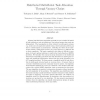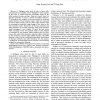584 search results - page 80 / 117 » Reinforcement Learning Task Clustering |
ICRA
2003
IEEE
14 years 2 months ago
2003
IEEE
Existing task allocation algorithms generally do not consider the effects of task interaction, such as interference, but instead assume that tasks are independent. That assumptio...
IEEEVAST
2010
13 years 3 months ago
2010
The process of learning models from raw data typically requires a substantial amount of user input during the model initialization phase. We present an assistive visualization sys...
ML
2000
ACM
13 years 8 months ago
2000
ACM
We present an approach to inductive concept learning using multiple models for time series. Our objective is to improve the efficiency and accuracy of concept learning by decomposi...
ICRA
2009
IEEE
13 years 6 months ago
2009
IEEE
A Skilligent robot must be able to learn skills autonomously to accomplish a task. "Skilligence" is the capacity of the robot to control behaviors reasonably, based on th...
ICCV
2003
IEEE
14 years 10 months ago
2003
IEEE
Feature space analysis is the main module in many computer vision tasks. The most popular technique, k-means clustering, however, has two inherent limitations: the clusters are co...


